Apple's iPhone 4: Thoroughly Reviewed
by Brian Klug & Anand Lal Shimpi on June 30, 2010 4:06 AM EST- Posted in
- Smartphones
- Apple
- iPhone 4
- Gadgets
- Mobile
FaceTime
Meet Manveer. I’ve known him since I was in the 6th grade. Somewhere around the 8th grade we started a ritual of calling each other every day after school and talking about video games, computers and dumb things that happened at school. We talked on the phone for hours. Back in those days we would even play the same game on separate computers while talking on the phone. It was a precursor to voice chat in gaming networks like Steam or Xbox Live. It was ridiculous amounts of fun.
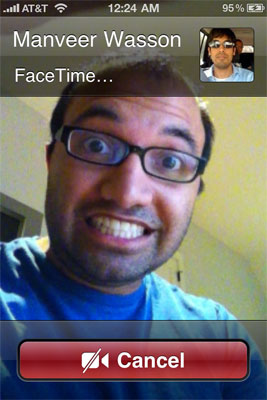
Manveer is up in the corner, the crazy guy is yours truly
Tonight Manveer and I FaceTimed. It’s the feature I wish we had when we were back in middle school. These days it’s a lot harder to explain why you’ve got some random dude’s face on your phone talking to you about completely pointless things at 12:54AM on a Tuesday night. I spent part of the chat covering one of the lights in my room with my head and calling it an Anand Head Eclipse. At the risk of further embarrassing myself publicly, it was fun.
For those of you who don’t know, FaceTime is Apple’s VoIP protocol built into the iPhone 4.
Granted we’ve been able to do this sort of thing for quite a while now over instant messenger networks. Integration into your smartphone is just the next logical step, and in the right conditions it works very well.
 |
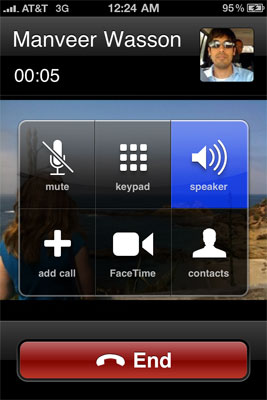 |
The first requirement is that both users need to have an iPhone 4 obviously. Both also need to be on WiFi. While the FaceTime icon will appear if you call another iPhone 4, if you try to activate the connection you’ll get this error unless you’re on WiFi:
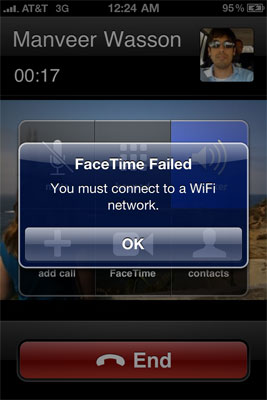
With a bit of poor UI design Apple will actually display a FaceTime icon with a question mark in it if you call another iOS phone. Trying to activate FaceTime however gives you an error.
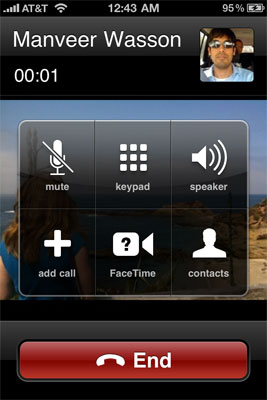 |
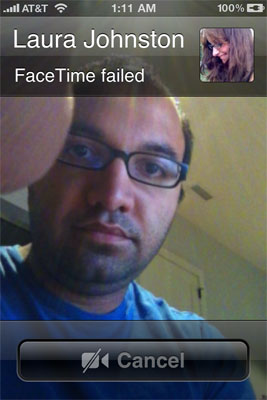 |
FaceTime requires roughly 100 - 150Kbps of bandwidth in both directions to work smoothly. The download should be fine but the upload is pretty high given that many broadband providers in the US are ridiculously stingy with their upload bandwidth. For FaceTime to work well you can’t be uploading or downloading anything large in the background, or if you are just throttle everything else to give you enough bandwidth to work with.
The next problem with FaceTime is the iPhone 4 lacks an absolutely necessary integrated stand. HTC got it perfect with the EVO 4G, unfortunately the 4 has no such thing. The closest you can get is Apple’s iPhone 4 dock, it’ll set you back $29 but it’s necessary to prevent you from getting tired holding your phone out in front of you. Laying the 4 down on your desk while you FaceTime just gives the person on the other end of the line a great view of your nostrils. Not very welcoming.
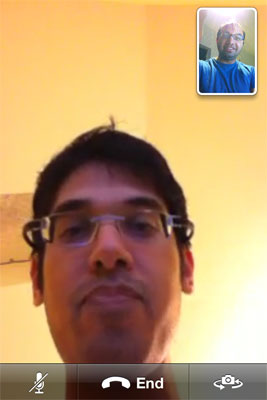
This is the on-table view of FaceTime, you need a stand
Even once you’ve met all of the requirements it’s still not a guaranteed thing. Even with ample bandwidth I had one FaceTime chat stall in the middle of the chat. My incoming feed froze and I had to wait a couple of seconds for it to resume. I also had a problem where FaceTime would fail to start on the first try. A subsequent try fixed it.
As you'll see in our camera investigation, the low light performance of the 4's front facing camera is horrid. Couple that with FaceTime and you will get bad image quality if you're not in a well lit room:

Ugh, what is this, 1998?
While in FaceTime you can easily switch between front and rear cameras by tapping the camera icon in the lower right corner. Unfortunately the compression on the video is enough to render text illegible while in FaceTime:
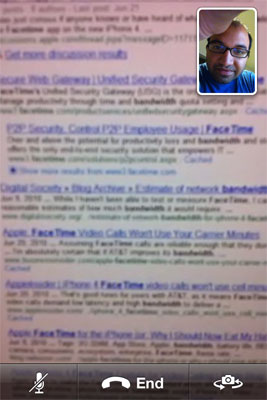
This was taken using the rear facing camera over FT
Obviously everyone knows where FaceTime is going. Apple is supposedly opening the protocol up to all developers, so you’d be able to theoretically build desktop and other smartphone FaceTime clients. And ultimately as mobile broadband speeds (hello WiMAX and LTE) improve the WiFi requirement will be dropped. But is it a good feature today?
It really depends on who you know with an iPhone 4. If you’ve got a Manveer, absolutely - the feature is worth it. If you have a bunch of casual acquaintances with iPhone 4s, probably not. It’s only useful if you know the person on the other side very well.
There is one other major benefit to FaceTime. Once enabled your call is routed over WiFi to the Internet, not AT&T’s 3G network. It doesn’t use any of your plan’s minutes and more importantly, voice quality is much improved over a regular 3G/EDGE phone call. It’s VoIP, not a crappy cell connection. Even if you just cover the camera it’s actually better to make calls over FaceTime than 3G based on the sound quality alone.










270 Comments
View All Comments
Griswold - Wednesday, June 30, 2010 - link
Lets be honest, he has only very limited means to meassure the problem. To get to the bottom of this, it needs to be meassured in a HF lab.samspqr - Wednesday, June 30, 2010 - link
"The fact that Apple didn't have the foresight to coat the stainless steel antenna band with even a fraction of an ounce worth of non-conductive material either tells us that Apple doesn't care or that it simply doesn't test thoroughly enough."I find it really funny that they would never catch this specific problem because of them just being apple: if their engineers are not as good as anand is (as in thinking "that's gonna be a problem" right after hearing the description of the antenna), and if THE FIELD TESTERS HAD THEIR PHONES DRESSED AS A 3GS BECAUSE OF PARANOID ISSUES, this kind of problem can only slip through
The0ne - Wednesday, June 30, 2010 - link
I think Anand was a little light on this topic. As an multi-discipline engineer myself this type of problem with the Antenna SHOULD NEVER had happened. It can only happened due to decisions that did not properly address it. This is not rocket science to engineers. If anything, testing WOULD HAVE discover the problem and yet it's in the finish product. Quite sad if you ask me.For example, why put a ferrite clamp on the end of the cable instead of designing it into the PCB . The only reason I can see why we did this was due to lack of time and we severely paid for it by having products become defective because the ferrite would pull the cables loose from the connectors.
deppbv78 - Wednesday, June 30, 2010 - link
I'm really disappointed at the lengths taken by AT to justify that iP4 losing signal as not a big deal...If it was any other product from any other manufacturer, I'm sure you'd not have gone to such lengths to justify the signal drop and just concluded that the phone has serious antenna problems. I'm not understanding why is it so difficult for anyone just provide an unbiased view of the product.I have HTC Hero & Touch Pro both of which lost a bar or two (with fluctuations) when cupped tightly. However, it was always just 1-2 bars and never went down like iPhone 4 does from 5 bars to 0. This continuous loss of signal is the problem. Justifying it telling that all phones lose signal is not right, as every other phone (including 3GS) loses signal temporarily and then stabilizes unlike iPhone 4.
No wonder the iPhone 4 is engineering marvel, but that set aside it is also true that the design has created issues as well and the reviews need to acknowledge it and not justify it
geniekid - Wednesday, June 30, 2010 - link
HTC Incredible owner here. I think AT successfully showed that the antenna issue is NOT a big deal and their methods for doing so are sound. I share your suspicion that maybe they wouldn't have made such a significant investigation if it had been another phone, but let's not accuse them of mistakes they haven't made yet.bplewis24 - Wednesday, June 30, 2010 - link
I have a sincere question though. Does this test really successfully show the antenna issue is NOT a big deal, or does it simply show that it's not a big deal in the utmost ideal conditions?Sometimes the article is difficult to decipher in terms of understanding who is saying what, but upon my initial reading I take it Brian did the testing of the antenna in Arizona. By his own admission (from my understanding), he lives there because the reception is absolutely stellar and about as good as it can possibly be.
Again, from what I can tell, it is under those conditions that he conducted the attenuation signal loss comparisons. If it still drops down to 1 bar and comes reasonably close to dropping calls under the best possible conditions, how does it react under "average" conditions? Other people are reporting dropped calls for a reason. Is Brian's test the norm or an outlier?
Please correct me if I've read this article wrong.
Brandon
anactoraaron - Wednesday, June 30, 2010 - link
My understanding is you are partially correct in assuming (which is what I interpreted from your post) that under "normal" or "average" conditions you will go to one bar - which with the improved reception even at 1 bar you are still fine - OR will drop signal completely.This is also the reason why they say "At the bare minimum Apple should give away its bumper case with every iPhone 4 sold."
Again, fantastic in-depth review.
strikeback03 - Thursday, July 1, 2010 - link
Well, he said the location he lives in has stellar reception. But he also said he drove around for a day testing, which implies to me that he found somewhere with a stable, "average" signal and did some testing there, then probably went somewhere with a "poor" signal and did some more, etc.bplewis24 - Friday, July 2, 2010 - link
@strikeback03Correct. And in driving around to the less-than-stellar areas showed the phone dropping down below -107dB for reception when showing less than 2 bars. And this is on the low end of the reception spectrum as described earlier in the article. So it's pretty clear that the antenna does INDEED show poor signal strength in average or less than average areas when the "death grip" is applied.
That is the determining factor. That determines that the design is defective and flawed. If it was not designed that way, when in average or below signal areas, the reception would still be average or below, and not well below because of the way you hold the phone.
However, the article skirts this and attempts to present it in a way that shines the best possible light on Apple and their defective design. Big disappointment in terms of an objective review.
Brandon
geniekid - Wednesday, June 30, 2010 - link
The article made it clear that bars are a misleading way of measuring call quality/reception. In practice, it was noted that call quality/reception is improved/equal to the 3GS on the 4, regardless of bars (raw signal power).Who cares if you have 1 bar all the time if you're still making calls better than someone with 4 bars?
HTC Incredible owner here.